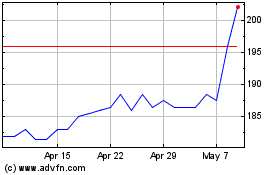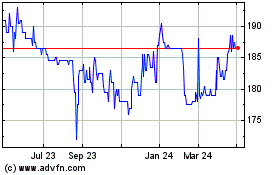BlackRock Income Portfolio Update
October 21 2019 - 10:44AM
UK Regulatory
TIDMBRIG
BLACKROCK INCOME AND GROWTH INVESTMENT TRUST PLC (LEI:5493003YBY59H9EJLJ16)
All information is at 30 September 2019 and unaudited.
Performance at month end with net income reinvested
Since
One Three One Three Five 1 April
Month Months Year Years Years 2012
Sterling
Share price 3.1% 3.1% 5.3% 17.7% 38.7% 96.3%
Net asset value 3.2% 1.9% 1.5% 18.3% 42.8% 84.2%
FTSE All-Share Total Return 3.0% 1.3% 2.7% 21.7% 38.9% 78.7%
Source: BlackRock
BlackRock took over the investment management of the Company with effect from
1 April 2012.
At month end
Sterling:
Net asset value - capital only: 201.66p
Net asset value - cum income*: 205.98p
Share price: 200.00p
Total assets (including income): GBP51.4m
Discount to cum-income NAV: 2.9%
Gearing: 5.1%
Net yield**: 3.5%
Ordinary shares in issue***: 23,017,476
Gearing range (as a % of net assets) 0-20%
Ongoing charges****: 1.1%
* includes net revenue of 4.32 pence per share
** The Company's yield based on dividends announced in the last 12 months as at
the date of the release of this announcement is 3.5% and includes the 2018
final dividend of 4.40p per share declared on 20 December 2018 and paid to
shareholders on 19 March 2019 and the 2019 interim dividend of 2.60p per share
declared on 25 June 2019 and paid to shareholders on 27 August 2019.
*** excludes 9,916,456 shares held in treasury
**** Calculated as a percentage of average net assets and using expenses,
excluding performance fees and interest costs for the year ended
31 October 2018.
Sector Analysis Total assets (%)
Oil & Gas Producers 9.8
Pharmaceuticals & Biotechnology 9.2
Media 9.1
Life Insurance 8.1
Support Services 7.1
Banks 6.8
Financial Services 5.6
Household Goods & Home Construction 5.4
Food Producers 5.1
Travel & Leisure 4.3
Tobacco 3.7
Food & Drug Retailers 3.3
Gas, Water & Multiutilities 3.2
Mining 3.1
Health Care Equipment & Services 2.9
Industrial Engineering 2.6
Mobile Telecommunications 2.2
Nonlife Insurance 2.0
Electronic & Electrical Equipment 1.2
Construction & Materials 0.9
Chemicals 0.6
General Retailers 0.5
Beverages 0.3
Net current assets 3.0
------
Total 100.0
======
Ten Largest Equity Investments
Company Total assets (%)
Royal Dutch Shell 'B' 6.4
AstraZeneca 4.9
GlaxoSmithKline 4.3
RELX 4.2
British American Tobacco 3.7
BP Group 3.5
Tesco 3.3
National Grid 3.2
BHP 3.1
Prudential 3.1
Commenting on the markets, Adam Avigdori and David Goldman representing the
Investment Manager noted:
The UK equity market traded sideways over the quarter, disguising a period of
weakness in August and a marked style rotation, out of momentum and into value,
at the beginning of September. Concerns around geopolitical risk, global trade
uncertainty and weakening global economic data did though create headwinds,
with intraday share prices influenced by ongoing news flow surrounding trade
tensions. Market concern spiked in August, with investors turning to safe-haven
assets as global government yields plunged to historical lows and the US
Treasury curve inverted between the 2 and 10-year yields, resuming fears of
impending recession as it has previously been a lead-indicator. Market risk was
balanced by central banks shifting monetary policy to a more dovish stance. The
US Federal Reserve cut rates by 50 basis points in Q3, aiming to ease
inflationary pressures and offset rising geopolitical tensions. The European
Central Bank introduced a comprehensive easing package, cutting the deposit
facility rate by 10 basis points to -0.5% and restarting asset purchases at the
pace of 20bln EUR per month, with a commitment to run the programme until its
2% inflation target was met. Emerging markets detracted the most throughout the
third quarter. Chinese assets took the biggest hit as disruptions in global
trade have begun to be reflected in the economic data. In August, Chinese
industrial production slowed to +4.8% year-on-year, the weakest in 17 years and
well below market expectations. In the UK, in June, newly-elected UK Prime
Minister Boris Johnson pledged to leave the European Union on October 31st with
or without a deal. Ever since, the Brexit debate has become more heated, with
the risks of a disruptive 'no-deal' Brexit still looming large. This, plus the
contraction in domestic GDP in the second quarter, led to additional weakness
in Sterling.
Over the quarter, the Company returned 2.01%, outperforming the benchmark
index, the FTSE All Share, which returned 1.27% in the same period.
The largest contributor was London Stock Exchange Group, one of the fund's core
holdings, whose shares rose further this month as the market further
appreciated the synergies and growth potential of the Refinitiv deal. Shares in
pest control specialist Rentokil also contributed this month. After the
positive set of trading results late in July, we met with the company's
management team and would note that the pest control division continues to be
the key driver with strong structural drivers in a fragmented industry. Medtech
player Smith & Nephew also contributed as shares rose further after a strong
trading statement released at the end of July where they upgraded revenue
guidance further. Shares were rallying through August as the investment
community further appraised what this entails for the company.
The largest detractor to the fund was Prudential whose shares were weak, not
only due to further potential rate cuts from the Fed against the ongoing
US-China trade tensions, but also the social unrest in Hong Kong. Its shares
saw a sharp sell-off prior to reporting H1 2019 results. The results themselves
highlighted that they are embarking on a strategy of organic and inorganic
diversification for their US business into Fixed Annuities, noting the poorer
conditions in the Variable Annuities market as distribution shifts from broker
to advised. Elsewhere in the group, Asia continues to deliver with no change in
its structural growth story, despite the aforementioned concerns. Shares in
John Laing detracted following a weak H1 2019 update with sizeable write-downs
on their wind assets in Australia and Germany citing issues of transmission/
regulatory and lack of wind respectively. These write-downs were more than
offset by value enhancements and project completions elsewhere such that NAV
still increased. Bodycote also detracted from performance. As a global cyclical
it is sensitive to market concerns about global growth. We felt its results
were reassuring in light of news flow from sector peers and where its highest
margin areas delivered. In our view, this is a differentiated and
well-capitalised industrial, with a management team we rate highly.
Over the quarter we initiated a position in Aviva, WPP and Grafton Group. We
added to positions in Standard Chartered, Taylor Wimpey, Phoenix Group, Smith &
Nephew, St James's Place, National Grid and Fuller Smith and Turner. We sold
our position in Imperial Brands. We have also trimmed exposure to Lloyds, John
Laing, BP, Rentokil, Barclays, Elementis and MoneySupermarket.com.
We continue to see a period of sustained growth. Importantly, we expect nominal
growth to remain modest as we see structural pressures from demographics,
corporate underinvestment and new technology continuing to act as a drag on
inflation. The dovish tilt from central banks is clearly supportive for
markets, however from time to time we expect markets to worry about a shift to
a more hawkish stance. With heightened political uncertainty and investor
nervousness, we expect volatility to return to markets. This provides us, as
active managers of a concentrated portfolio, with a great opportunity to
identify high-quality cash generative businesses, with robust balance sheets,
that can weather various market cycles and help to deliver long term capital
and income growth for our clients.
We continue to like cash generative consumer staple companies, especially those
exposed to the emerging market consumer given the prevalent demographic trends
in certain markets. These companies often generate substantial cash flow which
allows them to invest in innovation, marketing and distribution to ensure the
longevity of their brands while also paying attractive and growing dividends to
shareholders. We have also sought exposure to infrastructure spend whilst at
the same time we are watching for signs of overheating in the US and monitoring
economic growth in China. We also note that inflationary pressures are
starting to build and therefore we seek those companies with sufficient pricing
power and efficiency potential to withstand rising costs. As the recent past
has demonstrated, it is crucial to be selective and to focus on those companies
that are strong operators, that provide a differentiated service or product and
that boast a strong balance sheet.
END
(END) Dow Jones Newswires
October 21, 2019 10:44 ET (14:44 GMT)
Blackrock Income And Gro... (LSE:BRIG)
Historical Stock Chart
From Mar 2024 to Apr 2024

Blackrock Income And Gro... (LSE:BRIG)
Historical Stock Chart
From Apr 2023 to Apr 2024
